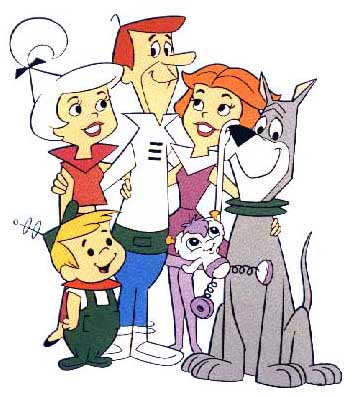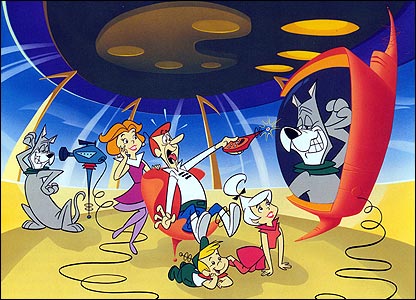The characters from The Jetsons are remembered easily because of the catchy-animated introduction which appeared at the start of each show.
To watch the animated introduction, CLICK HERE.
“The characters were introduced each week with what was probably the most easily memorized cartoon theme song of all time” (Erickson, 446). This was a staple of the show, and appeared before the beginning of each episode. The characters in Hanna-Barbera’s production, The Jetsons, were designed with the 1960s in mind:
“When cartoon-show creators William Hanna and Joseph Barbera strained their imaginations (ever so slightly) to picture the family of the future, it was a pretty simple exercise. Take your basic nuclear family: the modern, shop-happy housewife, the corporate-drone dad, two rambunctious kids and a dog; house them in a spacey-looking split-level; power their car with atomic energy; equip their home with a robot maid; and, whammo, you had it- a space-age Cleaver family named the Jetsons” (Wallis).
The typical nuclear family was envisioned continuing into the twenty-first century. The creators of the television show did not anticipate a growing number of single parents and homosexual couples raising children in the future. While they kept the 1950s family stereotype, The Jetsons provided a very effective cast for envisioning a future of technology.
Additionally, there was a somewhat sexist attitude towards women on the show. Jane Jetson (see below) was depicted as a shopaholic housewife, and sexist slurs referring to women including “lousy women drivers, battleaxe mothers-in-law, irrational jealousies and overextended department store charge accounts” (Erickson, 446) were common. This was much less common when new episodes appeared in the 1980s.

George Jetson:
George Jetson is the main character, and the focus of the television series. He is the head of household, and works for Spacely Space Sprockets as an indexer. For his job, he works only three hours each day, three days per week. He has the uncanny ability to make wrong decisions routinely, resulting in dilemmas which he must somehow correct. It is not uncommon for George’s boss: Mr. Spacely, to fire, rehire, promote and demote George. George has plain features and has the “air of a loser, another poor schmuck” (Stockman), which is similar to the role of Fred Flintstone from another Hanna-Barbera series. All in all, George does his best to provide for his family and give them the best life possible.
Jane Jetson:
Jane Jetson is George’s wife, and depicted as a typical housewife. Jane tends to the home and provides for her family, but also spends her time shopping for new gadgets and clothes. She is attractive and always dresses very well. In an ABC promo, Jane is described as “a typical housewife…spends more than her husband earns” this is only one of the sexist slurs present in the show. Jane’s relationship with George likely made this television show very relatable for many 1960s families.
Elroy Jetson:
Elroy is George and Jane’s genius son. He is a straight-A student at Little Dipper Elementary school. He is always making inventions and trying to make life better for everyone. He also enjoys average boy activities, including sports. Astro, the Jetsons’ canine companion, is often at Elroy’s side. He hardly ever does anything wrong. He has an ambiguous age, but it is expected between 6 and 12.
Judy Jetson:
Judy is George and Jane’s stereotypical teenage daughter. She attends Orbit High school, has a ponytail, and like her mother, goes for the latest trends and fashions. She loves rock and roll music, even dating Jet Screamer, a celebrity in an early episode. One of her most important possessions, DiDi, is a digital diary in which she tells all of her secrets.
Rosie the Robot:
Rosie is the Jetsons’ robot maid. She is not a new model robot, and is somewhat outdated, but she is treated as part of the family. She is responsible for tending to the house. During the 1960s, she appeared in only two episodes. When new episodes of the show were created for syndication, she appeared much more frequently.
Astro:
Astro is the Jetsons’ affectionate canine companion. He frequently annoys George, and is regarded as a member of the family. The show’s closing sequence depicts George walking Astro on the automatic walkway outside their home, and Astro taking control of George, dragging him around it over and over, while George yells for Jane to stop “this crazy thing”. Astro is able to talk, but can only mumble. “Ruh-roh” is one of his favorite phrases. Astro was adored by the audience so much, Hanna-Barbera shaped his character into the focus of another series, Scooby Doo (Erickson, 447).
Other Recurring Characters:
Other characters frequently appearing on the show include:
Orbitty- The Jetson’s pet alien, which appears only in the 1980s episodes
Cosmo Spacely- George’s tyrannical boss
W.C. Cogswell- Owner of Cogswell Cogs, Cosmo Spacely’s competitor
Henry Orbit- The superintendent of Skypad Apartments, who invents gadgets to do maintenance work
Voice Cast:
George Jetson- George O’Hanlon
Jane Jetson- Penny Singleton
Elroy Jetson- Daws Butler
Judy Jetson- Janet Waldo
Rosie the Robot- Jean Vander Pyl
Astro- Don Messick (later became the voice of Scooby Doo)
Cosmo Spacely- Mel Blanc
Orbitty- Frank Welker
|


